check engine TOYOTA YARIS HYBRID 2015 Owners Manual
[x] Cancel search | Manufacturer: TOYOTA, Model Year: 2015, Model line: YARIS HYBRID, Model: TOYOTA YARIS HYBRID 2015Pages: 492, PDF Size: 21.93 MB
Page 4 of 492
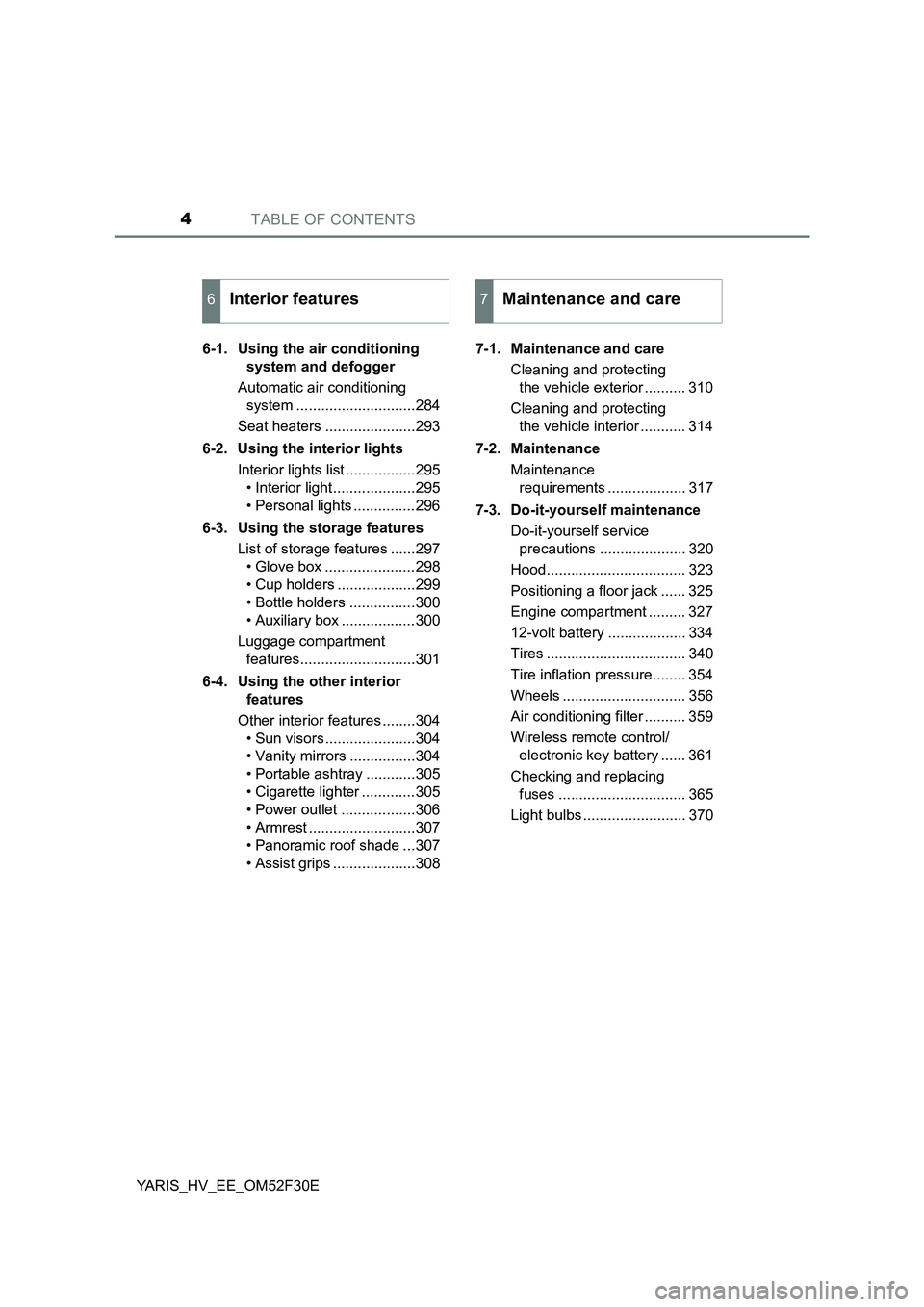
TABLE OF CONTENTS4
YARIS_HV_EE_OM52F30E
6-1. Using the air conditioning
system and defogger
Automatic air conditioning
system .............................284
Seat heaters ......................293
6-2. Using the interior lights
Interior lights list .................295
• Interior light ....................295
• Personal lights ...............296
6-3. Using the storage features
List of storage features ......297
• Glove box ......................298
• Cup holders ...................299
• Bottle holders ................300
• Auxiliary box ..................300
Luggage compartment
features............................301
6-4. Using the other interior
features
Other interior features ........304
• Sun visors ......................304
• Vanity mirrors ................304
• Portable ashtray ............305
• Cigarette lighter .............305
• Power outlet ..................306
• Armrest ..........................307
• Panoramic roof shade ...307
• Assist grips ....................308
7-1. Maintenance and care
Cleaning and protecting
the vehicle exterior .......... 310
Cleaning and protecting
the vehicle interior ........... 314
7-2. Maintenance
Maintenance
requirements ................... 317
7-3. Do-it-yourself maintenance
Do-it-yourself service
precautions ..................... 320
Hood.................................. 323
Positioning a floor jack ...... 325
Engine compartment ......... 327
12-volt battery ................... 334
Tires .................................. 340
Tire inflation pressure........ 354
Wheels .............................. 356
Air conditioning filter .......... 359
Wireless remote control/
electronic key battery ...... 361
Checking and replacing
fuses ............................... 365
Light bulbs ......................... 370
6Interior features7Maintenance and care
Page 13 of 492
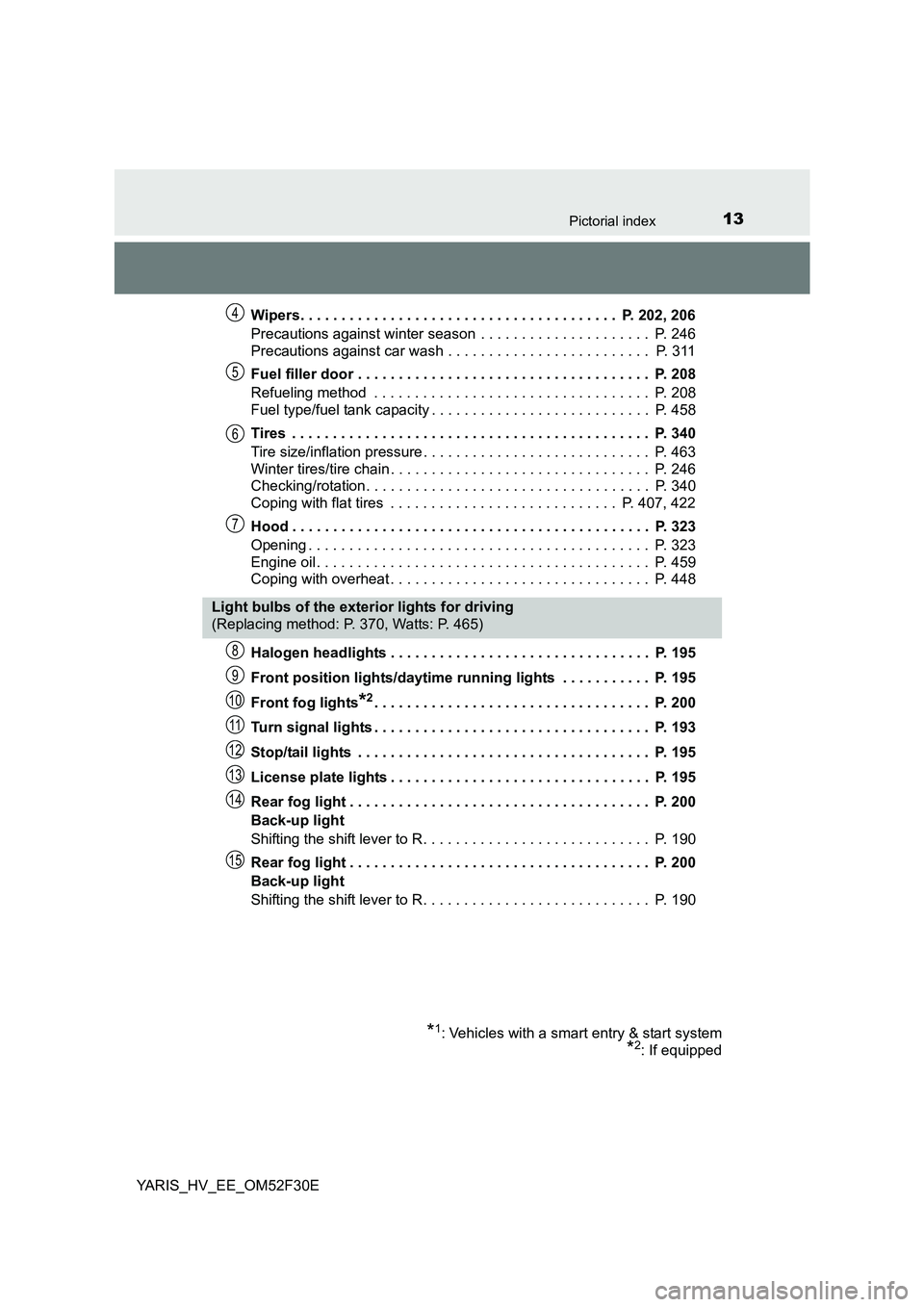
13Pictorial index
YARIS_HV_EE_OM52F30E
Wipers. . . . . . . . . . . . . . . . . . . . . . . . . . . . . . . . . . . . . . . P. 202, 206
Precautions against winter season . . . . . . . . . . . . . . . . . . . . . P. 246
Precautions against car wash . . . . . . . . . . . . . . . . . . . . . . . . . P. 311
Fuel filler door . . . . . . . . . . . . . . . . . . . . . . . . . . . . . . . . . . . . P. 208
Refueling method . . . . . . . . . . . . . . . . . . . . . . . . . . . . . . . . . . P. 208
Fuel type/fuel tank capacity . . . . . . . . . . . . . . . . . . . . . . . . . . . P. 458
Tires . . . . . . . . . . . . . . . . . . . . . . . . . . . . . . . . . . . . . . . . . . . . P. 340
Tire size/inflation pressure . . . . . . . . . . . . . . . . . . . . . . . . . . . . P. 463
Winter tires/tire chain . . . . . . . . . . . . . . . . . . . . . . . . . . . . . . . . P. 246
Checking/rotation. . . . . . . . . . . . . . . . . . . . . . . . . . . . . . . . . . . P. 340
Coping with flat tires . . . . . . . . . . . . . . . . . . . . . . . . . . . . P. 407, 422
Hood . . . . . . . . . . . . . . . . . . . . . . . . . . . . . . . . . . . . . . . . . . . . P. 323
Opening . . . . . . . . . . . . . . . . . . . . . . . . . . . . . . . . . . . . . . . . . . P. 323
Engine oil . . . . . . . . . . . . . . . . . . . . . . . . . . . . . . . . . . . . . . . . . P. 459
Coping with overheat . . . . . . . . . . . . . . . . . . . . . . . . . . . . . . . . P. 448
Halogen headlights . . . . . . . . . . . . . . . . . . . . . . . . . . . . . . . . P. 195
Front position lights/daytime running lights . . . . . . . . . . . P. 195
Front fog lights*2. . . . . . . . . . . . . . . . . . . . . . . . . . . . . . . . . . P. 200
Turn signal lights . . . . . . . . . . . . . . . . . . . . . . . . . . . . . . . . . . P. 193
Stop/tail lights . . . . . . . . . . . . . . . . . . . . . . . . . . . . . . . . . . . . P. 195
License plate lights . . . . . . . . . . . . . . . . . . . . . . . . . . . . . . . . P. 195
Rear fog light . . . . . . . . . . . . . . . . . . . . . . . . . . . . . . . . . . . . . P. 200
Back-up light
Shifting the shift lever to R. . . . . . . . . . . . . . . . . . . . . . . . . . . . P. 190
Rear fog light . . . . . . . . . . . . . . . . . . . . . . . . . . . . . . . . . . . . . P. 200
Back-up light
Shifting the shift lever to R. . . . . . . . . . . . . . . . . . . . . . . . . . . . P. 190
4
5
6
7
Light bulbs of the exterior lights for driving
(Replacing method: P. 370, Watts: P. 465)
*1: Vehicles with a smart entry & start system
*2: If equipped
8
9
10
11
12
13
14
15
Page 96 of 492
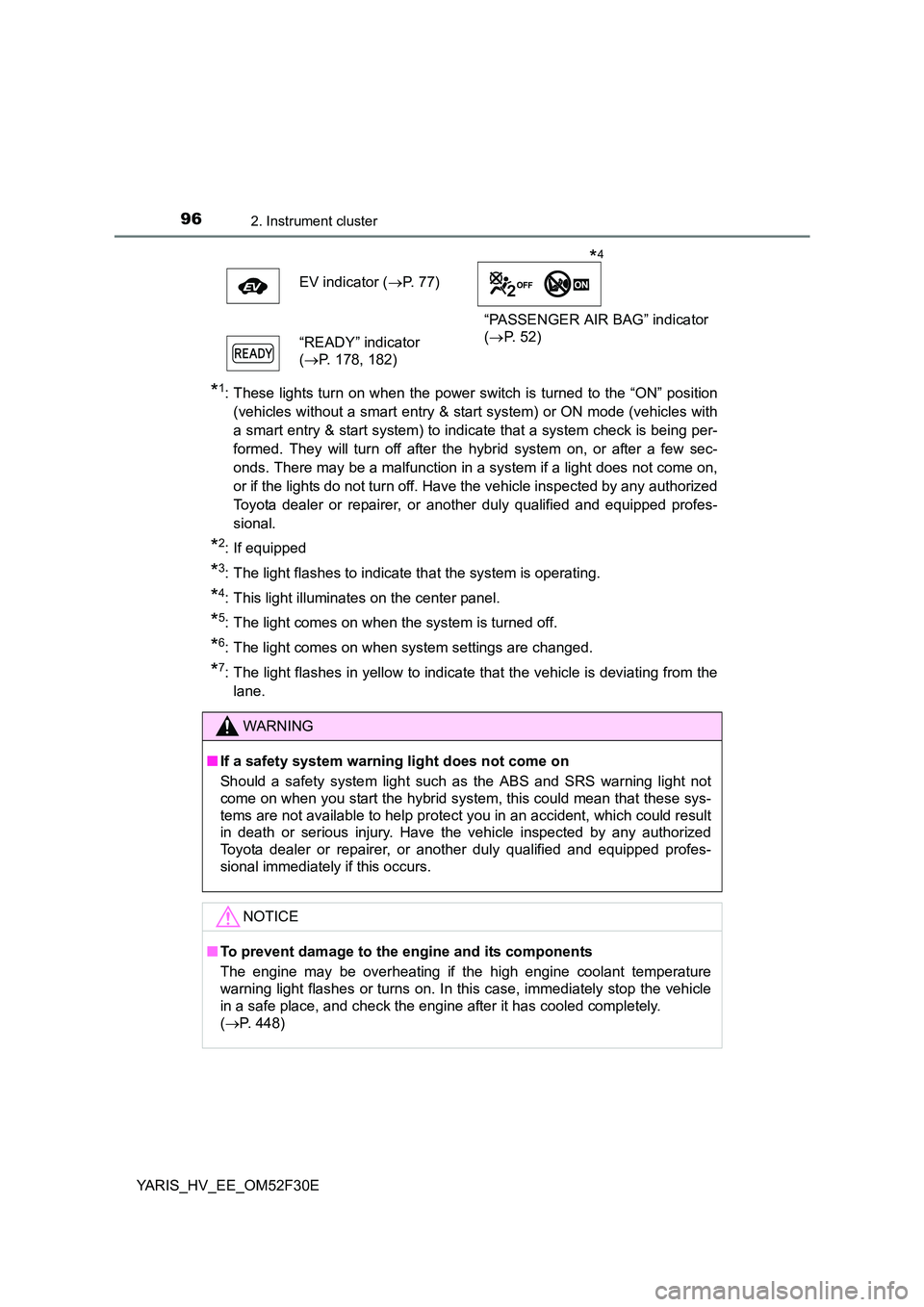
962. Instrument cluster
YARIS_HV_EE_OM52F30E
*1: These lights turn on when the power switch is turned to the “ON” position
(vehicles without a smart entry & star t system) or ON mode (vehicles with
a smart entry & start system) to indicate that a system check is being per-
formed. They will turn off after the hybrid system on, or after a few sec-
onds. There may be a malfunction in a system if a light does not come on,
or if the lights do not turn off. Have the vehicle inspected by any authorized
Toyota dealer or repairer, or another duly qualified and equipped profes-
sional.
*2: If equipped
*3: The light flashes to indicate that the system is operating.
*4: This light illuminates on the center panel.
*5: The light comes on when the system is turned off.
*6: The light comes on when system settings are changed.
*7: The light flashes in yellow to indicate that the vehicle is deviating from the
lane.
EV indicator ( →P. 77)
“PASSENGER AIR BAG” indicator
( →P. 52) “READY” indicator
( →P. 178, 182)
WARNING
■ If a safety system warning light does not come on
Should a safety system light such as the ABS and SRS warning light not
come on when you start the hybrid system, this could mean that these sys-
tems are not available to help protect you in an accident, which could result
in death or serious injury. Have the vehicle inspected by any authorized
Toyota dealer or repairer, or another duly qualified and equipped profes-
sional immediately if this occurs.
NOTICE
■ To prevent damage to the engine and its components
The engine may be overheating if the high engine coolant temperature
warning light flashes or turns on. In this case, immediately stop the vehicle
in a safe place, and check the engine after it has cooled completely.
( →P. 448)
*4
Page 170 of 492
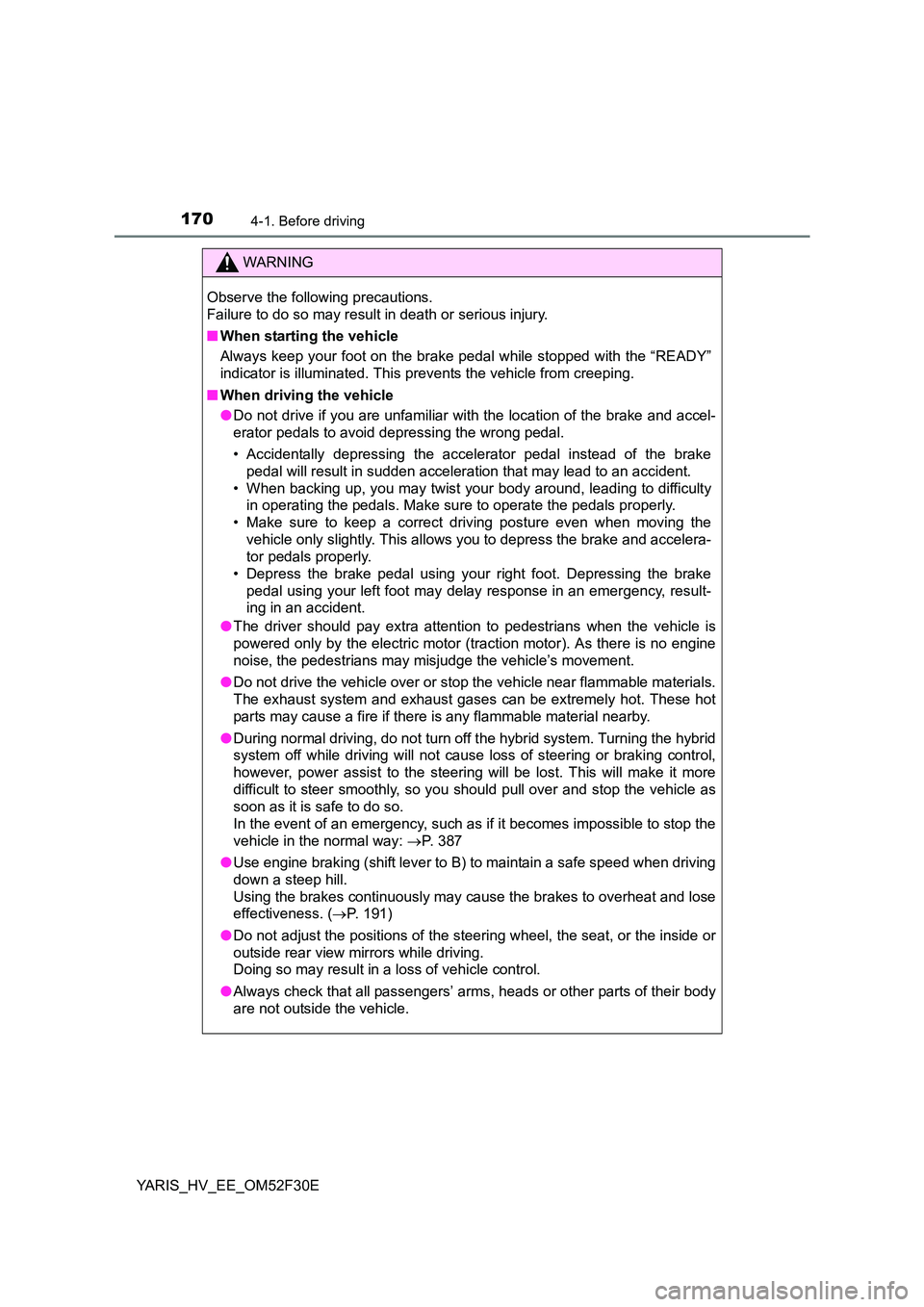
1704-1. Before driving
YARIS_HV_EE_OM52F30E
WARNING
Observe the following precautions.
Failure to do so may result in death or serious injury.
■ When starting the vehicle
Always keep your foot on the brake pedal while stopped with the “READY”
indicator is illuminated. This prevents the vehicle from creeping.
■ When driving the vehicle
● Do not drive if you are unfamiliar with the location of the brake and accel-
erator pedals to avoid depressing the wrong pedal.
• Accidentally depressing the accelerator pedal instead of the brake
pedal will result in sudden acceleration that may lead to an accident.
• When backing up, you may twist your body around, leading to difficulty
in operating the pedals. Make su re to operate the pedals properly.
• Make sure to keep a correct driving posture even when moving the
vehicle only slightly. This allows you to depress the brake and accelera-
tor pedals properly.
• Depress the brake pedal using your right foot. Depressing the brake
pedal using your left foot may delay response in an emergency, result-
ing in an accident.
● The driver should pay extra attention to pedestrians when the vehicle is
powered only by the electric motor (traction motor). As there is no engine
noise, the pedestrians may misjudge the vehicle’s movement.
● Do not drive the vehicle over or stop the vehicle near flammable materials.
The exhaust system and exhaust gases can be extremely hot. These hot
parts may cause a fire if there is any flammable material nearby.
● During normal driving, do not turn off the hybrid system. Turning the hybrid
system off while driving will not cause loss of steering or braking control,
however, power assist to the steering will be lost. This will make it more
difficult to steer smoothly, so you should pull over and stop the vehicle as
soon as it is safe to do so.
In the event of an emergency, such as if it becomes impossible to stop the
vehicle in the normal way: →P. 387
● Use engine braking (shift lever to B) to maintain a safe speed when driving
down a steep hill.
Using the brakes continuously may cause the brakes to overheat and lose
effectiveness. ( →P. 191)
● Do not adjust the positions of the steering wheel, the seat, or the inside or
outside rear view mirrors while driving.
Doing so may result in a loss of vehicle control.
● Always check that all passengers’ arms, heads or other parts of their body
are not outside the vehicle.
Page 172 of 492
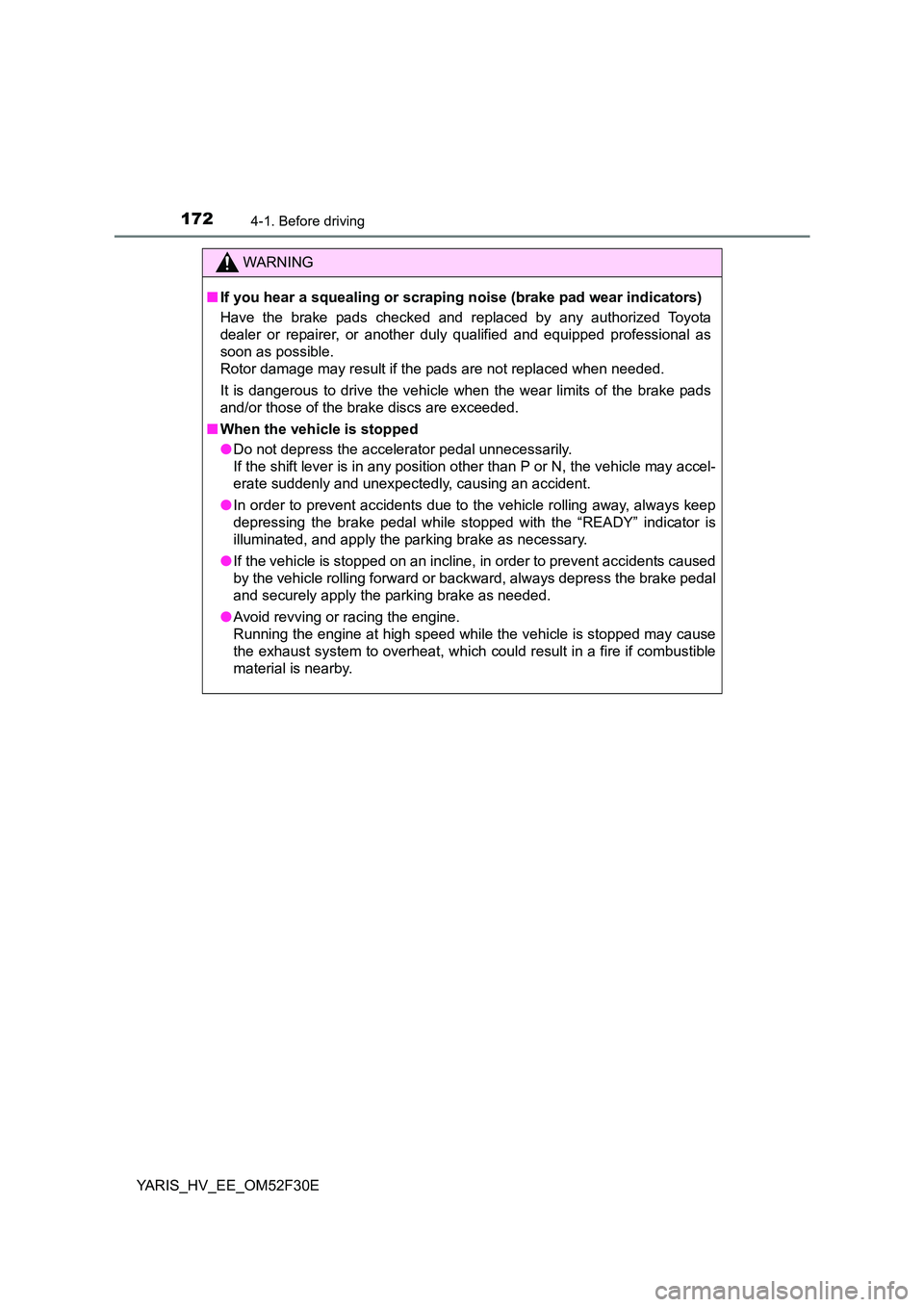
1724-1. Before driving
YARIS_HV_EE_OM52F30E
WARNING
■ If you hear a squealing or scraping noise (brake pad wear indicators)
Have the brake pads checked and replaced by any authorized Toyota
dealer or repairer, or another dul y qualified and equipped professional as
soon as possible.
Rotor damage may result if the pads are not replaced when needed.
It is dangerous to drive the vehicle when the wear limits of the brake pads
and/or those of the brake discs are exceeded.
■ When the vehicle is stopped
● Do not depress the accelerator pedal unnecessarily.
If the shift lever is in any position other than P or N, the vehicle may accel-
erate suddenly and unexpectedly, causing an accident.
● In order to prevent accidents due to the vehicle rolling away, always keep
depressing the brake pedal while stopped with the “READY” indicator is
illuminated, and apply the parking brake as necessary.
● If the vehicle is stopped on an incline, in order to prevent accidents caused
by the vehicle rolling forward or backward, always depress the brake pedal
and securely apply the parking brake as needed.
● Avoid revving or racing the engine.
Running the engine at high speed while the vehicle is stopped may cause
the exhaust system to overheat, which could result in a fire if combustible
material is nearby.
Page 175 of 492
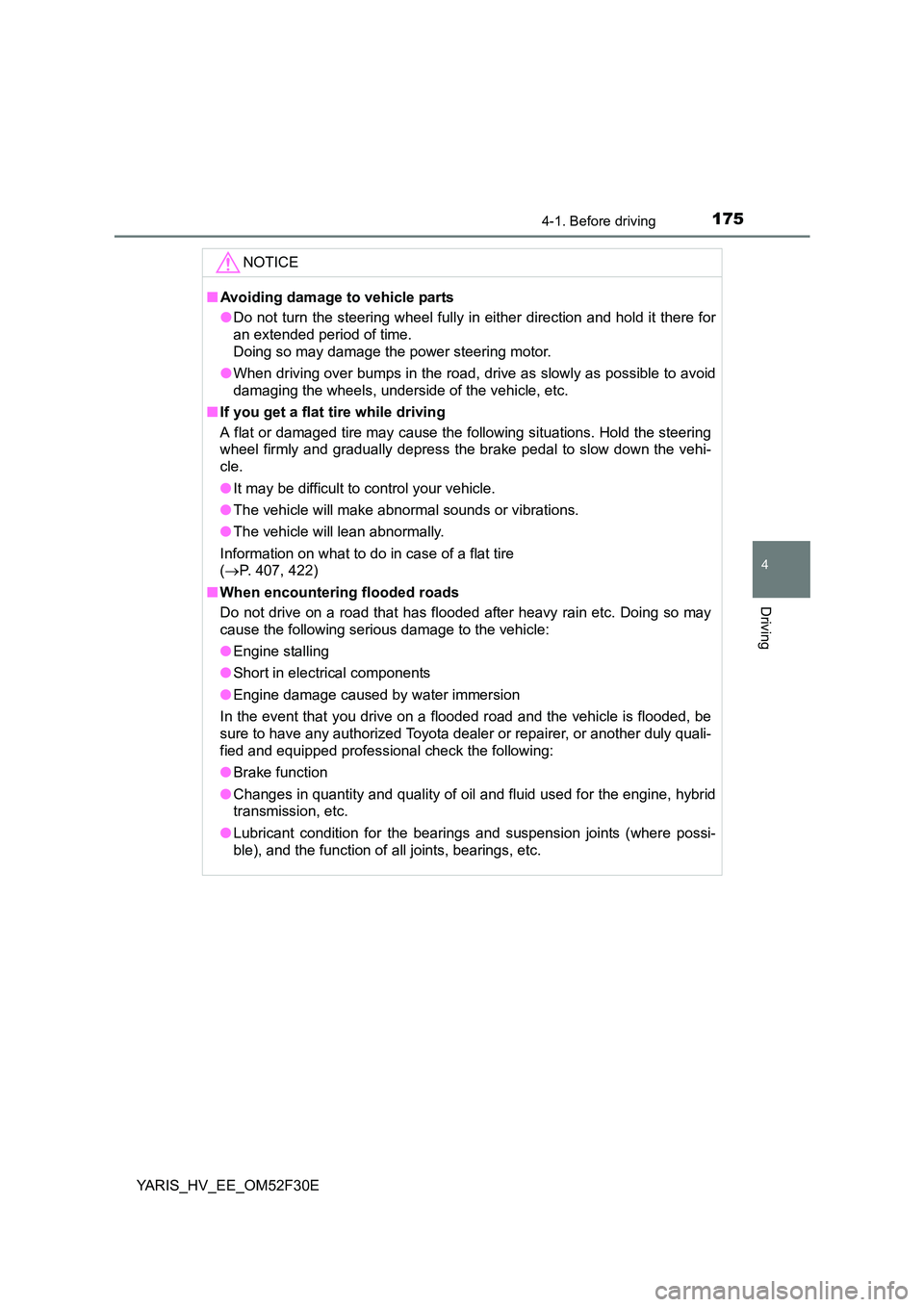
1754-1. Before driving
4
Driving
YARIS_HV_EE_OM52F30E
NOTICE
■ Avoiding damage to vehicle parts
● Do not turn the steering wheel fully in either direction and hold it there for
an extended period of time.
Doing so may damage the power steering motor.
● When driving over bumps in the road, drive as slowly as possible to avoid
damaging the wheels, underside of the vehicle, etc.
■ If you get a flat tire while driving
A flat or damaged tire may cause the following situations. Hold the steering
wheel firmly and gradually depress the brake pedal to slow down the vehi-
cle.
● It may be difficult to control your vehicle.
● The vehicle will make abnormal sounds or vibrations.
● The vehicle will lean abnormally.
Information on what to do in case of a flat tire
( →P. 407, 422)
■ When encountering flooded roads
Do not drive on a road that has flooded after heavy rain etc. Doing so may
cause the following serious damage to the vehicle:
● Engine stalling
● Short in electrical components
● Engine damage caused by water immersion
In the event that you drive on a flooded road and the vehicle is flooded, be
sure to have any authorized Toyota deale r or repairer, or another duly quali-
fied and equipped professional check the following:
● Brake function
● Changes in quantity and quality of oil and fluid used for the engine, hybrid
transmission, etc.
● Lubricant condition for the bearings and suspension joints (where possi-
ble), and the function of all joints, bearings, etc.
Page 244 of 492
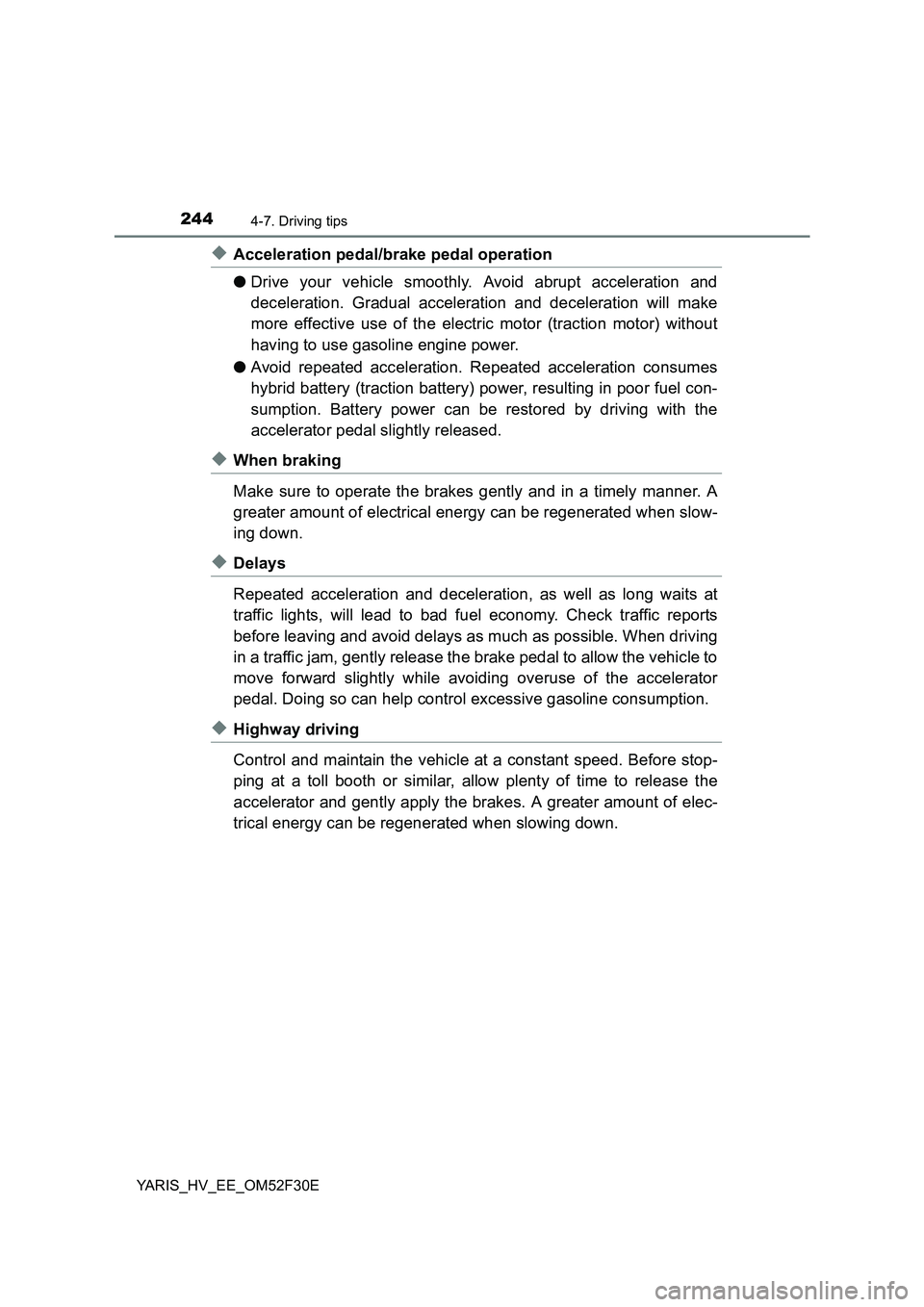
2444-7. Driving tips
YARIS_HV_EE_OM52F30E
◆Acceleration pedal/brake pedal operation
● Drive your vehicle smoothly. Avoid abrupt acceleration and
deceleration. Gradual acceleration and deceleration will make
more effective use of the electric motor (traction motor) without
having to use gasoline engine power.
● Avoid repeated acceleration. Repeated acceleration consumes
hybrid battery (traction battery) power, resulting in poor fuel con-
sumption. Battery power can be restored by driving with the
accelerator pedal slightly released.
◆When braking
Make sure to operate the brakes gently and in a timely manner. A
greater amount of electrical energy can be regenerated when slow-
ing down.
◆Delays
Repeated acceleration and deceleration, as well as long waits at
traffic lights, will lead to bad fuel economy. Check traffic reports
before leaving and avoid delays as much as possible. When driving
in a traffic jam, gently release the brake pedal to allow the vehicle to
move forward slightly while avoiding overuse of the accelerator
pedal. Doing so can help control excessive gasoline consumption.
◆Highway driving
Control and maintain the vehicle at a constant speed. Before stop-
ping at a toll booth or similar, allow plenty of time to release the
accelerator and gently apply the brakes. A greater amount of elec-
trical energy can be regenerated when slowing down.
Page 245 of 492
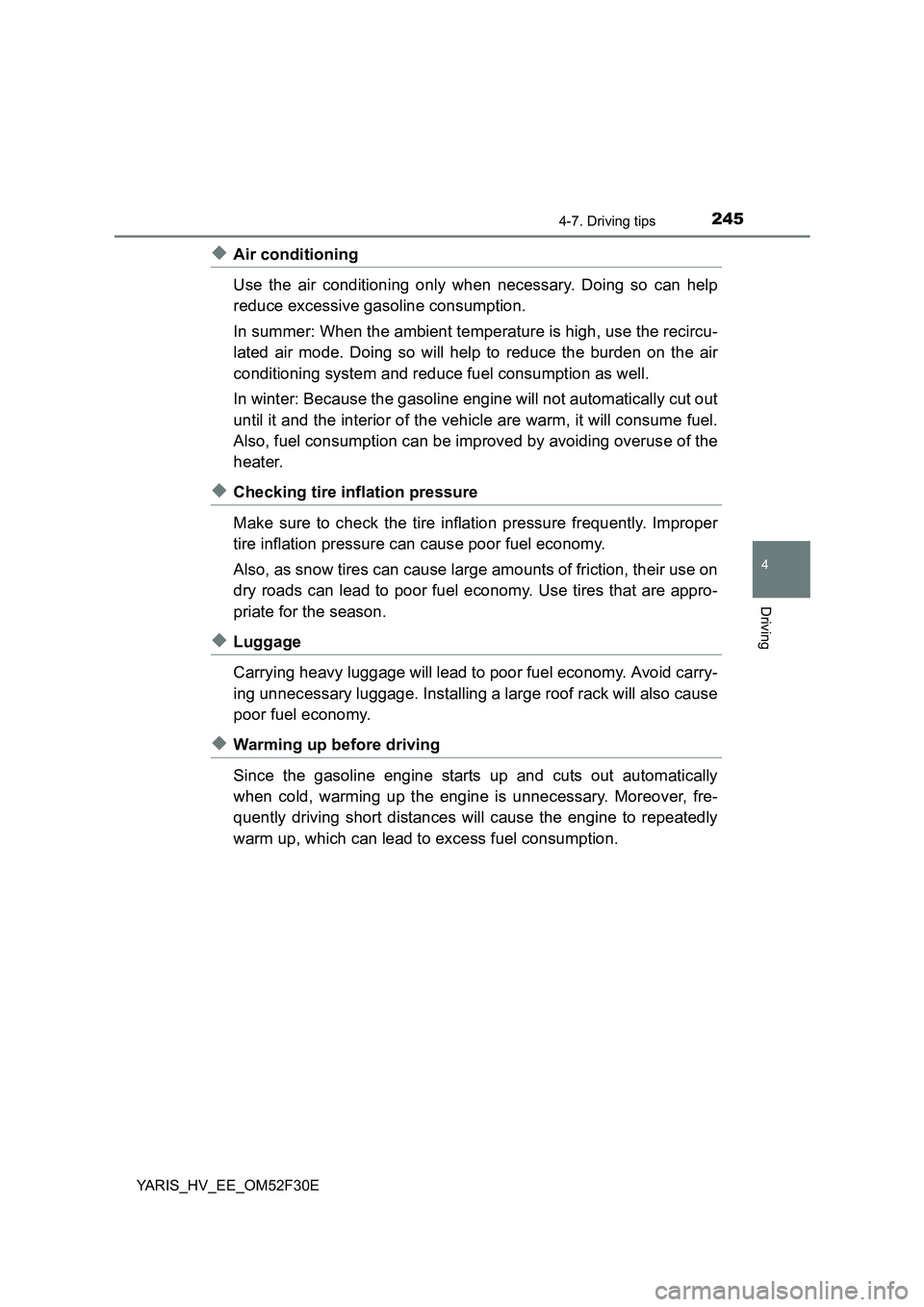
2454-7. Driving tips
4
Driving
YARIS_HV_EE_OM52F30E
◆Air conditioning
Use the air conditioning only when necessary. Doing so can help
reduce excessive gasoline consumption.
In summer: When the ambient temperature is high, use the recircu-
lated air mode. Doing so will help to reduce the burden on the air
conditioning system and reduce fuel consumption as well.
In winter: Because the gasoline engine will not automatically cut out
until it and the interior of the vehicle are warm, it will consume fuel.
Also, fuel consumption can be improved by avoiding overuse of the
heater.
◆Checking tire inflation pressure
Make sure to check the tire inflation pressure frequently. Improper
tire inflation pressure can cause poor fuel economy.
Also, as snow tires can cause large amounts of friction, their use on
dry roads can lead to poor fuel economy. Use tires that are appro-
priate for the season.
◆Luggage
Carrying heavy luggage will lead to poor fuel economy. Avoid carry-
ing unnecessary luggage. Installing a large roof rack will also cause
poor fuel economy.
◆Warming up before driving
Since the gasoline engine starts up and cuts out automatically
when cold, warming up the engine is unnecessary. Moreover, fre-
quently driving short distances will cause the engine to repeatedly
warm up, which can lead to excess fuel consumption.
Page 246 of 492

2464-7. Driving tips
YARIS_HV_EE_OM52F30E
Winter driving tips
●Use fluids that are appropriate to the prevailing outside tempera-
tures.
• Engine oil
• Engine/power control unit coolant
• Washer fluid
• Power control unit coolant (hybrid system)
● Have a service technician inspect the condition of the 12-volt bat-
tery.
● Have the vehicle fitted with four snow tires or purchase a set of tire
chains for the front tires.
Ensure that all tires are the same size and brand, and that their wear
level is not noticeably different with each other. Also make sure that
chains match the size of the tires.
Perform the following according to the driving conditions:
● Do not try to forcibly open a window or move a wiper that is frozen.
Pour warm water over the frozen area to melt the ice. Wipe away
the water immediately to prevent it from freezing.
● To ensure proper operation of the climate control system fan,
remove any snow that has accumulated on the air inlet vents in
front of the windshield.
● Check for and remove any excess ice or snow that may have accu-
mulated on the exterior lights, vehicle’s roof, chassis, around the
tires or on the brakes.
● Remove any snow or mud from the bottom of your shoes before
getting in the vehicle.
Carry out the necessary preparations and inspections before
driving the vehicle in winter. Always drive the vehicle in a man-
ner appropriate to the prevailing weather conditions.
Preparation for winter
Before driving the vehicle
Page 309 of 492
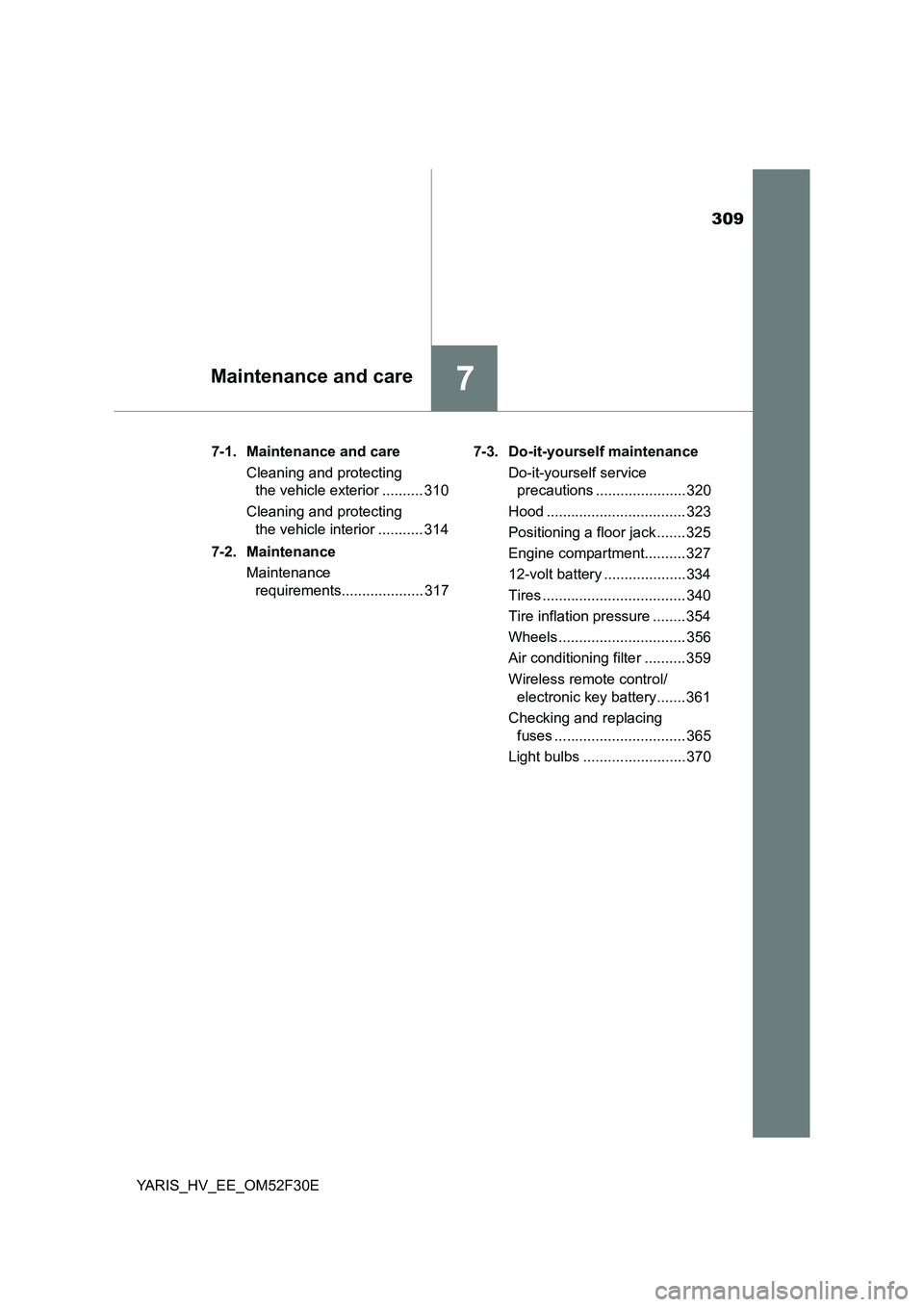
309
7Maintenance and care
YARIS_HV_EE_OM52F30E
7-1. Maintenance and care
Cleaning and protecting
the vehicle exterior .......... 310
Cleaning and protecting
the vehicle interior ........... 314
7-2. Maintenance
Maintenance
requirements.................... 317
7-3. Do-it-yourself maintenance
Do-it-yourself service
precautions ...................... 320
Hood .................................. 323
Positioning a floor jack ....... 325
Engine compartment.......... 327
12-volt battery .................... 334
Tires ................................... 340
Tire inflation pressure ........ 354
Wheels ............................... 356
Air conditioning filter .......... 359
Wireless remote control/
electronic key battery....... 361
Checking and replacing
fuses ................................ 365
Light bulbs ......................... 370